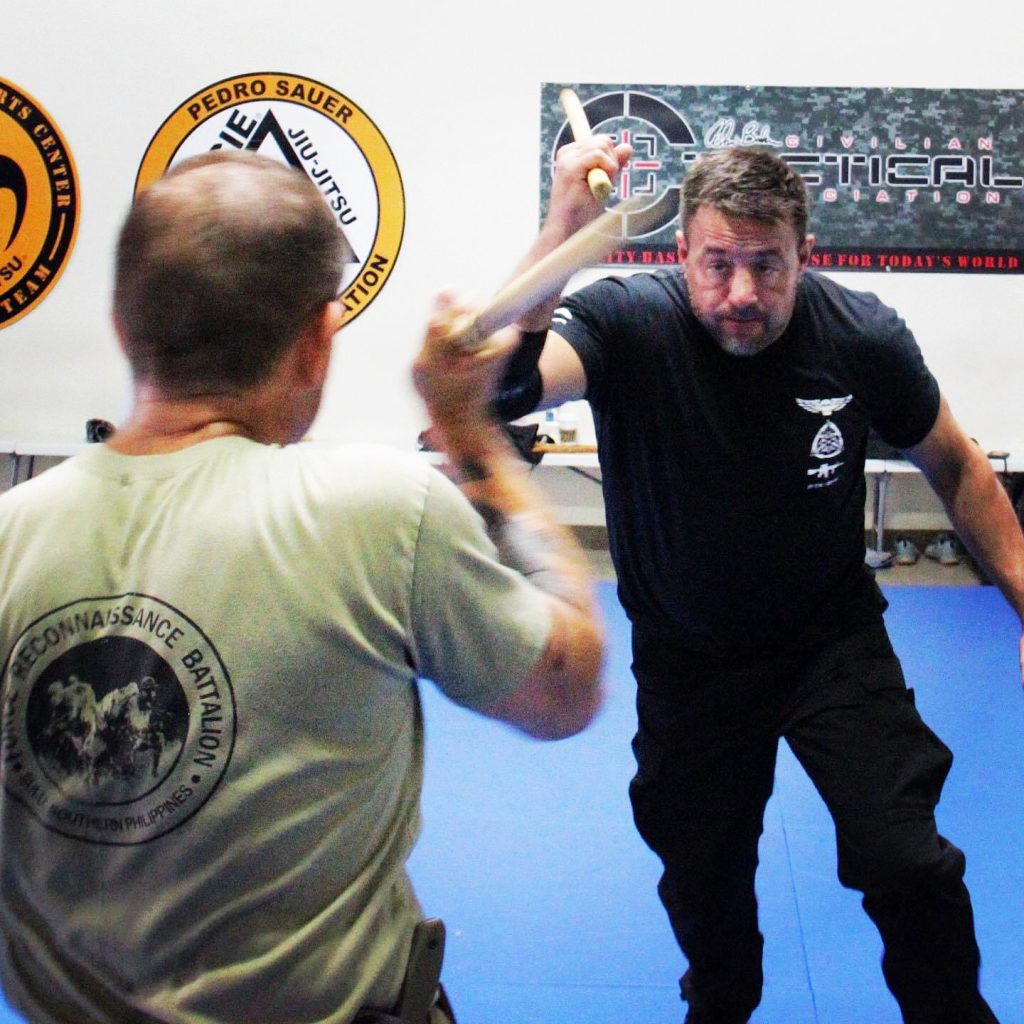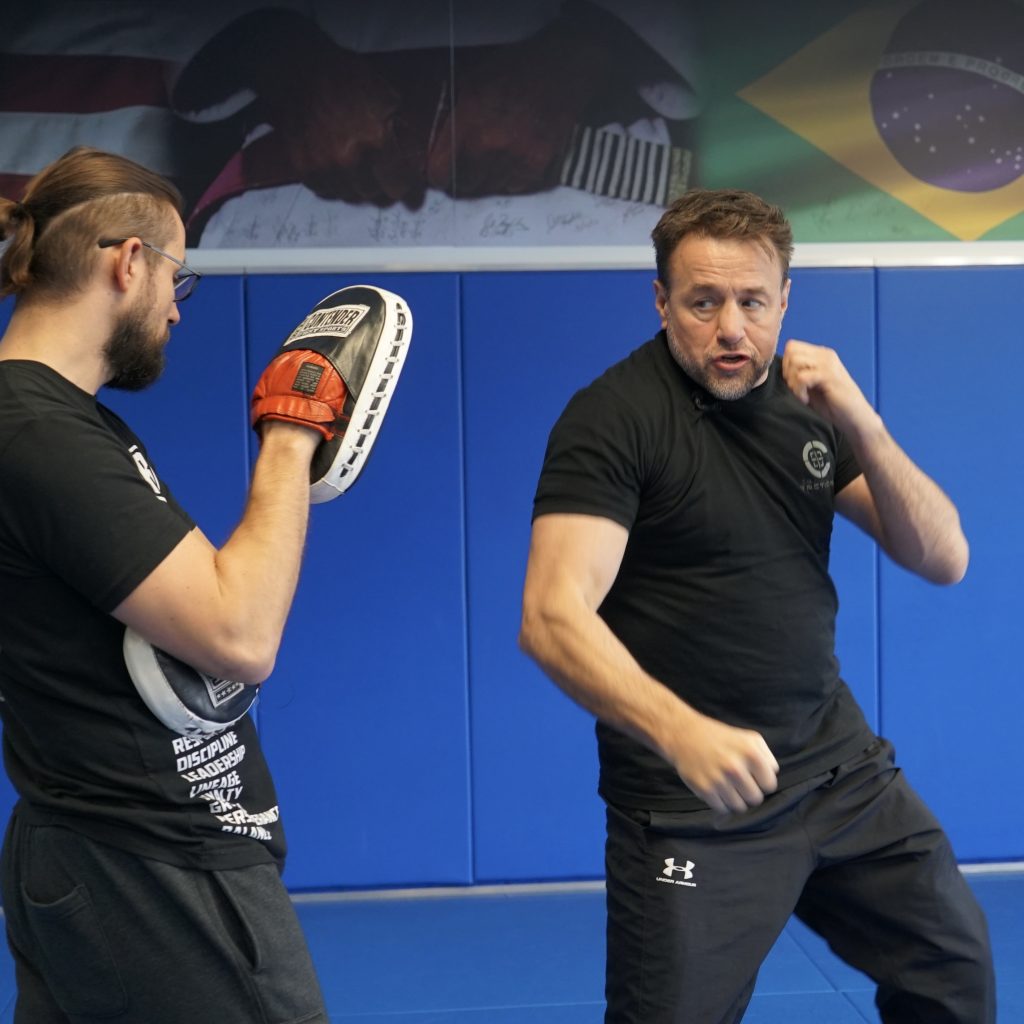
In defensive tactics and combat training, traditional concepts like the “reactionary gap” and the inevitability of sympathetic nervous system (SNS) responses have long influenced training methodologies. However, advancements in neuroscience and a deeper understanding of human physiology suggest that with proper training, these perceived limitations can be mitigated, leading to enhanced performance in high-stress situations. This is something I frequently discuss with one of my teachers and mentors, Tuhon Tim Waid. Yes, Tuhon Tim Waid is a highly respected authority in Pekiti-Tirsia Kali (PTK), a Filipino martial arts system known for its blade-based combat training, edged weapon tactics, and combative strategy. He is recognized as one of the leading instructors in the Pekiti-Tirsia system, having trained extensively under Grand Tuhon Leo T. Gaje, Jr.
Tim Waid is known for his no-nonsense, combat-proven approach to training, emphasizing real-world application over sport or demonstration. His Pekiti-Tirsia Kali Tactical Training System has been integrated into military, law enforcement, and counter-terrorism units worldwide, reinforcing the effectiveness of PTK in close-quarters combat and edged weapon engagements. He has played a significant role in preserving and advancing the traditional combat principles of PTK while adapting them for modern tactical use. I’ve been very fortunate to train was too high tim since around 2010.
Beyond the Reactionary Gap
The “reactionary gap” refers to the physical distance between a defender and an aggressor, dictating the time required to respond effectively to an attack. Traditional training often emphasizes maintaining this gap to allow for defensive reactions, but this approach is inherently reactive rather than proactive. By developing advanced pattern recognition and judgment skills, practitioners can anticipate threats before they fully materialize, allowing them to neutralize danger with greater efficiency and control.
This proactive mindset shifts the focus away from merely reacting to an attack and instead prioritizes preemptive action, ensuring that even if an opponent initiates an engagement, a well-trained defender can dictate the outcome through decisive and strategic movement.
This principle aligns directly with a key concept I teach regularly—the study of critical distance. In my view, this study of the combat gap and its effective bridging is an art in itself, one that demands the same level of attention as any other fundamental combat skill. Unfortunately, as we’ve discussed, this concept is often overlooked in many modern martial arts, despite its crucial role in real-world combat effectiveness. Understanding and mastering critical distance is whatseparates a skilled combatant from one who is merely reacting, allowing for greater control over the flow and tempo of an engagement.
Controlling the Sympathetic Nervous System Response

During high-stress encounters, the body’s sympathetic nervous system (SNS) triggers a cascade of physiological responses, including tunnel vision, auditory exclusion, and a reliance on gross motor movements. While these reactions are natural survival mechanisms, they are not insurmountable obstacles. Dr. Andrew Huberman, a renowned neuroscientist, has highlighted that specific training protocols can help individuals regulate their nervous system responses and maintain clarity and control under pressure. One such method is the “physiological sigh”—a double inhale followed by a prolonged exhale, which activates the parasympathetic nervous system, promoting calmness, focus, and reduced stress reactivity.
As a strong proponent of breath training, I consider breathing control an essential study for anyone involved in combat science. In my teaching, I introduce students to what I call the “Full Cycle Breath”, which I consider to be the alphabet of breathing—a foundational practice that serves as a structured and intelligent educational process for developing personalized breathing patterns based on specific needs. This training directly aligns with what Dr. Huberman has explored, leading to the same physiological and cognitive benefits.
One of the key aspects I emphasize in breath training is the connection between exhalation and tension control. Many high-level Qigong systems from traditional Kung Fu lineages have refined this concept to an extraordinary degree, teaching practitioners how to manipulate their body’s internal systems with precision. These systems represent some of the most advanced methodologies in the martial arts world for achieving true physiological mastery.
With that in mind, I believe there is more to this than what Dr. Huberman has currently explored. While his work is scientifically sound and valuable, I suspect that if he had the opportunity to study traditional Chinese martial arts in-depth, he would discover even greater insights into breath control, body regulation, and stress management. That said, I agree with his core findings—I simply believe that there is an even more effective and structured approach than what he is currently advocating.
The Importance of “Bridging” in Combat

Closing the distance between oneself and an opponent, known as “bridging,” is a critical yet often overlooked aspect of combat training. Effective bridging allows a defender to control the engagement, disrupt the opponent’s strategy, and apply techniques with greater precision. This concept is emphasized by Tuhon Tim.
Historically, disciplines like swordsmanship have underscored the importance of closing the distance. General George S. Patton, an accomplished fencer and designer of the 1913 Cavalry Saber, advocated for the retention of edged weapons in military training, stating that only close combat weapons instill the fierce resolve to engage the enemy directly. This perspective highlights the enduring significance of bridging in combat scenarios.
In modern contexts, the principle of bridging remains vital. For instance, in boxing, effectively closing the distance can determine the outcome of a match. However, improper execution can lead to vulnerabilities, as seen in instances wherefighters have been countered during their approach.
Understanding and mastering the art of bridging not only enhances offensive capabilities but also fortifies defensive strategies, making it an indispensable component of comprehensive combat training.
Integrating Modern Neuroscience into Combat Training
Modern combat training benefits immensely from integrating neuroscientific insights. Understanding how the brain and body respond under stress enables the development of training programs that not only enhance physical skills but alsocultivate mental resilience. By incorporating stress inoculation techniques, controlled exposure to high-pressure scenarios, and cognitive drills that enhance situational awareness, practitioners can train their nervous systems to maintain optimal performance, even when faced with unexpected threats.
The evolution of combat training necessitates a departure from outdated doctrines that view physiological responses as fixed limitations. By embracing proactive strategies, such as enhancing pattern recognition and mastering bridging techniques, and by leveraging neuroscientific methods to regulate the body’s stress responses, individuals can achieve superior performance in defensive situations. This holistic approach ensures that practitioners are not only physically prepared but also mentally equipped to handle the complexities of real-world confrontations.

Alan Baker is renowned for his dual expertise in crafting tailored Defensive Tactics Programs and high-performance coaching. Catering specifically to law enforcement agencies, military organizations, and security firms, Alan designs training regimens that emphasize practical techniques, real-world adaptability, and scenario-based training. His approach enhances the capabilities and readiness of personnel in intense situations. His clients include the Executive Protection Institute, Vehicle Dynamics Institute, The Warrior Poet Society, ALIVE Active Shooter Training, Retired Navy SEAL Jason Redman, Tactical 21, and many others. Sifu Alan is the creator of the C-Tac® (Civilian Tactical Training Association) System and
Protection Response Tactics (PRT), two highly regarded training systems that emphasize realistic, adaptive techniques for both civilians and professionals in high-risk fields. Explore Alan’s tailored programs here. Sifu Alan travels across the U.S., teaching camps and seminars on the programs he’s developed and the multiple martial arts he has studied for nearly five decades.
Beyond mere tactics, Alan stands out as the paramount “Self Leadership” coach, adept at unlocking the vast potential within individuals. With a deep passion for mentoring professionals, entrepreneurs, and those on personal growth odysseys, he focuses on nurturing a mindset of excellence. Alan’s coaching hinges on practical strategies that bolster mental resilience, focus, and drive. Teaming up with Alan means embarking on a transformative path where mental barriers are dismantled, inherent strengths come to the fore, and your goals become within clear sight. His profound insights enhance performance and sculpt a mindset tailored for triumphant success.
To delve deeper into Alan’s mindset philosophy, peruse his enlightening collection of books. If you’re ready to amplify your journey under Alan’s tutelage, connect through his official website.
